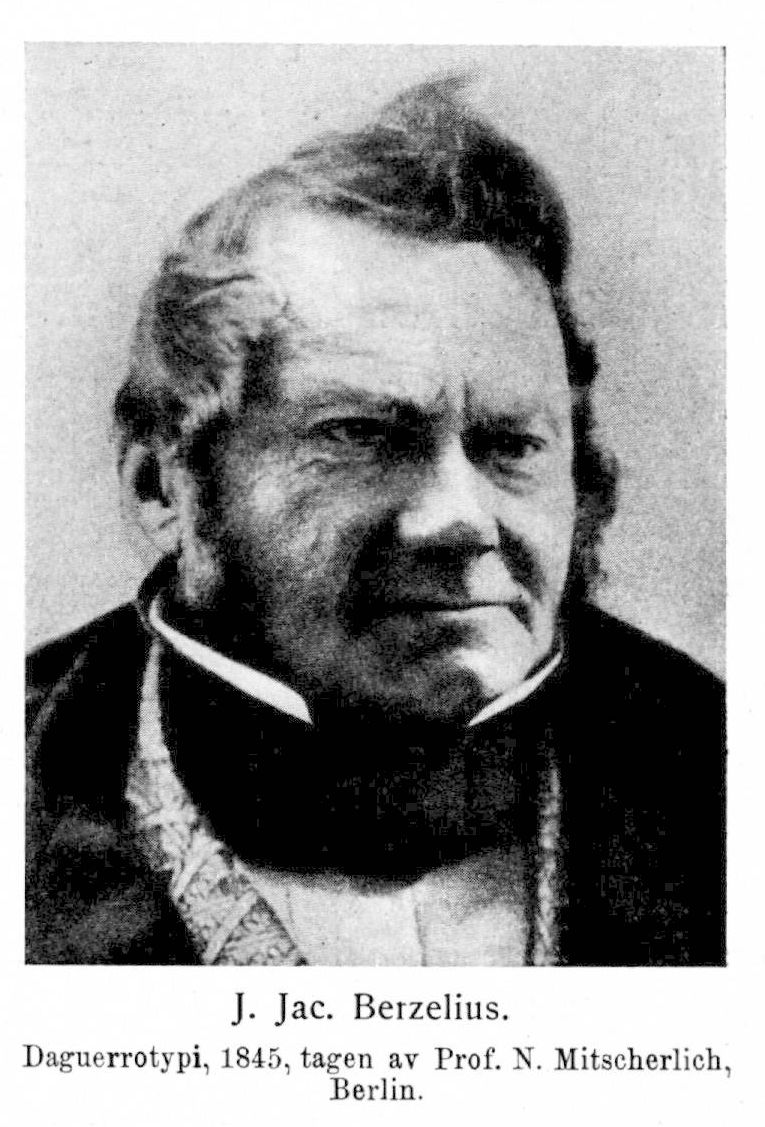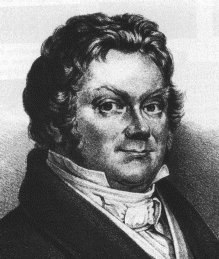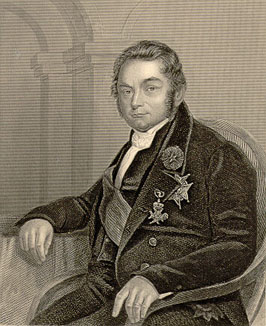Jöns Jacob Berzelius
Jöns Jakob Berzelius [ Jöns ˌ ʝɑ ː ː kɔb bæɹse liɵs ] ( born August 20, 1779 at Väversunda socks, Östergötland; † August 7, 1848 in Stockholm) was a Swedish physician and chemist. He is considered the father of modern chemistry.
Berzelius introduced the chemical symbol language with the letters of the chemical elements and the first time defines a plurality of the atomic masses of elements precisely. Berzelius developed a first model for understanding the electrolysis and nutrient cycling through the adoption of a positive and a negative charge in each particle ( dualist theory ). He also discovered new elements ( cerium, selenium, thorium), other elements were first presented by it in elemental form ( silicon, zirconium, titanium, tantalum, vanadium ).
Life and work
Jöns Jakob Berzelius lost at the age of four years his father, Samuel Berzelius (1743-1783), who died of tuberculosis. Samuel Berzelius was a pastor and teacher in Linkoping, his mother Anna Christina came from the Väversunda far away (see Vadstena (municipality ) ). After her mother's death Jöns Jacob came at the age of nine with his sister to his uncle Daniel Berzelius (1749-1807), who had seven children and was married to an alcoholic wife.
The name of Berzelius is a Latinized form of the name Bergsäter or mountain -seat; originally were called the ancestors of Berzelius but Hakannson and inhabited the Good Bergsäter at Motala.
He studied from 1796 medicine at Uppsala University, where he in 1802 anfertigte a thesis on the effects of galvanic electricity on patients. In this work he showed that this was of no practical use. In 1802 Berzelius was an unpaid employee in surgical institute in Stockholm.
His first chemical experiences he gained through the analysis of mineral waters. This led to an unpaid office at the College of Medicine in Stockholm, where he at the home of William Hisinger, a rich scientific amateur, lived together and performed electrochemical studies with him. Berzelius himself later complained, Humphry Davy had them the most benefit. In 1807 he became a professor of medicine and pharmacy in Stockholm ( Karolinska Institutet ) and began his comprehensive studies of chemical compounds. A year later he was elected to the Swedish Academy of Sciences and was its president from 1810. 1818 we raised him to the peerage, 1835, he became the lord.
Berzelius was, if not described as very spirited irritable. He worked closely with his former student Friedrich Wöhler. Among his pupils were in Stockholm Gottlieb Gmelin, Heinrich and Gustav Rose, Friedrich Wöhler and Gustav Magnus.
Scientific work
Electrochemical theory
In 1802 Berzelius examined with Hisinger the decomposition of a salt solution through a Voltaic pile (electrolysis ). He noted that an alkali metal salt solution is converted by the photovoltaic column in an acid and a base. He assumed that atom groups would behave like little magnets. A particle can react electropositive, electronegative or unipolar with a voltaic column. Berzelius assumed that all salts - inorganic and organic - would consist of a positive and a negative pole and small molecular magnets showed. In a positive electrostatic - magnetic molecule outweighs the positive charge, a negative charge, the electronegative particle. According to his theory consisted of potassium sulfate from the electro- positively charged particles KO and the electro- negatively charged SO3.
The dualistic theory of chemical substances remained for 20 years, the prevailing view in chemistry, to Jean Baptiste Dumas for organic chemistry discovered the radical substitution. Later the salts have been detected in aqueous solution as ions ( e.g. K ) by Michael Faraday and Svante Arrhenius. This proved that the dualistic theory was wrong. Today it uses the findings of the dualistic theory in the creation of oxidation numbers for redox equations to specify the charge number of an atom in a molecule part. The terms " electropositive " and " electronegative " have been preserved for the identification of a polarized bond in a molecule.
Atomic masses
The oxygen was the most negative element of Berzelius; all the elements are connected with the oxygen had have an electropositive charge. Some elements such as sulfur could sometimes electro- positive as well as electro- negative ( in the sulfur dioxide of sulfur is electropositive, electronegative than metal sulfide ). He sorted the elements into a power series. For Berzelius the electronegative oxygen of the focal point for his further attempts was. The particularly important role of oxygen lay in his ability with metals to produce well- identifiable compounds and also contained all the known acids and bases oxygen. Only Davy could represent the first acid without oxygen, the hydrochloric acid. Berzelius gave the oxygen arbitrary atomic mass 100 and referred all other atomic masses on the oxygen. Later he chose as a reference point and the hydrogen. Preparations for his exact investigations to determine the atomic mass formed the atomic theory of John Dalton, the work of Carl Friedrich Wenzel (1740-1793) and the law of multiple proportions of Jeremias Benjamin Richter.
On the basis of precipitates to form metal oxides and other precipitation reactions and subsequent mass determination Berzelius was the atomic mass of 40 elements between 1808-1818 to determine. This work formed a milestone in the development of chemistry. Some metal oxides ( Fe2O3, Fe3O4) is not an integer multiple formed to the metal atom, at the ratios at 2:3 he suspected chemical mixtures from 1:1 1:2 ( 2:3 ). He therefore calculated in these metal oxides twice the atomic mass. In 1827 Berzelius published an improved atomic mass table. You also still contained the elements chlorine and nitrogen.
New chemical elements
Berzelius also discovered new chemical elements and renamed it. With Hisinger he discovered the oxide of the element cerium, this name was assigned on the basis of the newly discovered by the Italian Giuseppe Piazzi planet Ceres. 1817 Berzelius discovered in analyzes in chemical factory at Gripsholm next to the tellurium ( presentation by Martin Heinrich Klaproth ), the element selenium ( 1818) (Greek selene = moon). His student Johan August Arfwedson discovered several new minerals ( Petalitos, spodumene, lepidolite ). A new element named Lithium (Greek lithos = stone) was found in these minerals. In another mineral from Norway, he discovered the thorium (named after the Germanic god of thunder, Thor). A number of other substances he could win in elemental form by the action of potassium on the corresponding halides. These include silicon ( 1823), zirconium (1823 ), titanium, tantalum (1824 ), thorium (1826 ) and vanadium ( Vanadis, the Scandinavian goddess of beauty ).
Chemical element symbols
Even Lavoisier and John Dalton had developed chemical element symbols. Berzelius called the atoms with the first letter or the first and another letter from the Latin word. By attachment of the atom number after the atom has a chemical formula could now be specified for a material, such as H2O. For double atoms in a formula for the Atom was ruled out of him sometimes. Sometimes Berzelius also put dots and dashes in mineralogical information. The abbreviation for latin names and the presentation of the empirical formula has prevailed and is still valid today.
Examples of element symbols of Berzelius:
- H for hydrogen ( hydrogenium )
- O for oxygen ( oxygenium )
- Fe for iron ( ferrum )
- Pb for lead ( plumbum ) and
- Hg for mercury ( hydrargyrum )
Others
Berzelius recognized that substances with the same composition could have different properties. He called this effect isomerism. The occurrence of elements in various forms he called allotropy. In 1835 he was discovered by the Eilhard Mitscherlich, Humphry Davy, Andreas Johann Wolfgang Dobereiner Libavius and accelerated the transformation by an excipient which it does not change the name of catalysis. The minerals that were previously classified according to external characteristics, he classified according to their chemical composition. In organic chemistry, he tried to support his dualistic principle of the matter by his radical theory. The free radical theory, however, was later rejected by Jean -Baptiste Dumas. He put in its place in 1834, the substitution theory (also see History of the substitution reaction).
Berzelius used the first time the concept of Organic Chemistry ( Organisk Kemi ). Between 1808 and 1830, the six volumes of his textbook for chemistry appeared ( Lärbok i kemien ). The textbook has been translated into many languages and influenced the development of chemistry in the 19th century decisively. It was translated into German by Friedrich Wöhler. From 1821 Berzelius the annual reports on the progress of the physical sciences issued regularly. He led Beaker, funnel, filter paper, rubber hoses, alcohol burner ( Berzeliuslampe ), water and desiccator for the chemical laboratory.
Honors and Memberships
Berzelius was in the Masonic Lodge of St. John 's Lodge included St. Erik 1805 in Stockholm in the covenant of freemasons. In 1808 he became a member of the Royal Swedish Academy of Sciences in Stockholm. From 1819 until his death he was secretary of the Academy, which he has thoroughly reformed. In 1813 he was admitted as a " Foreign Member " of the Royal Society, the Copley Medal in 1836 awarded him. In 1818 he was elected a member of the Scholars Academy Leopoldina. In 1837 he became a member of Svenska academies. In 1842 he received the Prussian Order Pour le Mérite for Sciences and Arts. In 1835 he became Baron.
The lunar crater Berzelius is named after him.
Works (selection)
- De electricitatis galvanicæ Apparatu cel. Volta excitæ in corpora organica effectu (Latin ), 1802 (scanned available online)
- The saidschitzer Bitter Water: chemically analyzed. Haase, Prague 1840 ( urn: nbn: de: HBZ :061:2 - 14327 )
- J. Jacob Berzelius, Lehrbuch der Chemie, vol 1.1 (2nd edition 1825), translated by F. Wöhler
- J. Jacob Berzelius, Lehrbuch der Chemie, Vol 1 (5th edition 1856), German
- J. Jacob Berzelius, Lehrbuch der Chemie, vol 2.1 (1st edition 1826), translated by F. Wöhler
- J. Jacob Berzelius, Lehrbuch der Chemie, vol 2.2 (1st edition 1826), translated by F. Wöhler
- J. Jacob Berzelius, Lehrbuch der Chemie, Vol 2 (5th edition 1856), German
- J. Jacob Berzelius, Lehrbuch der Chemie, vol 3.1 (1st edition 1827), translated by F. Wöhler
- J. Jacob Berzelius, Lehrbuch der Chemie, vol 3.2 (1st edition 1828), translated by F. Wöhler
- J. Jacob Berzelius, Lehrbuch der Chemie, Vol 3 (5th edition 1856), German
- J. Jacob Berzelius, Lehrbuch der Chemie, vol 4.1 - Thier chemistry (1st edition 1831), translated by F. Wöhler
- J. Jacob Berzelius, Lehrbuch der Chemie, vol 4.2 - Chemical operations and implements (1st edition 1831), translated by F. Wöhler
- J. Jacob Berzelius, Lehrbuch der Chemie, Vol 4 (5th edition 1856), German
- J. Jacob Berzelius, Lehrbuch der Chemie, Vol 5 (5th edition 1856), German
- J. Jacob Berzelius, Lehrbuch der Chemie, Vol 6 ( 3rd edition 1837), translated by F. Wöhler
- J. Jacob Berzelius, Lehrbuch der Chemie, Vol 7 ( 4th ed 1838), translated by F. Wöhler
- J. Jacob Berzelius, Lehrbuch der Chemie, Vol 8 ( 4th ed 1839), translated by F. Wöhler
- J. Jacob Berzelius, Lehrbuch der Chemie, Vol 9 ( 4th ed 1840), translated by F. Wöhler
- J. Jacob Berzelius, Lehrbuch der Chemie, Vol 10 ( 3rd edition 1841), translated by F. Wöhler










